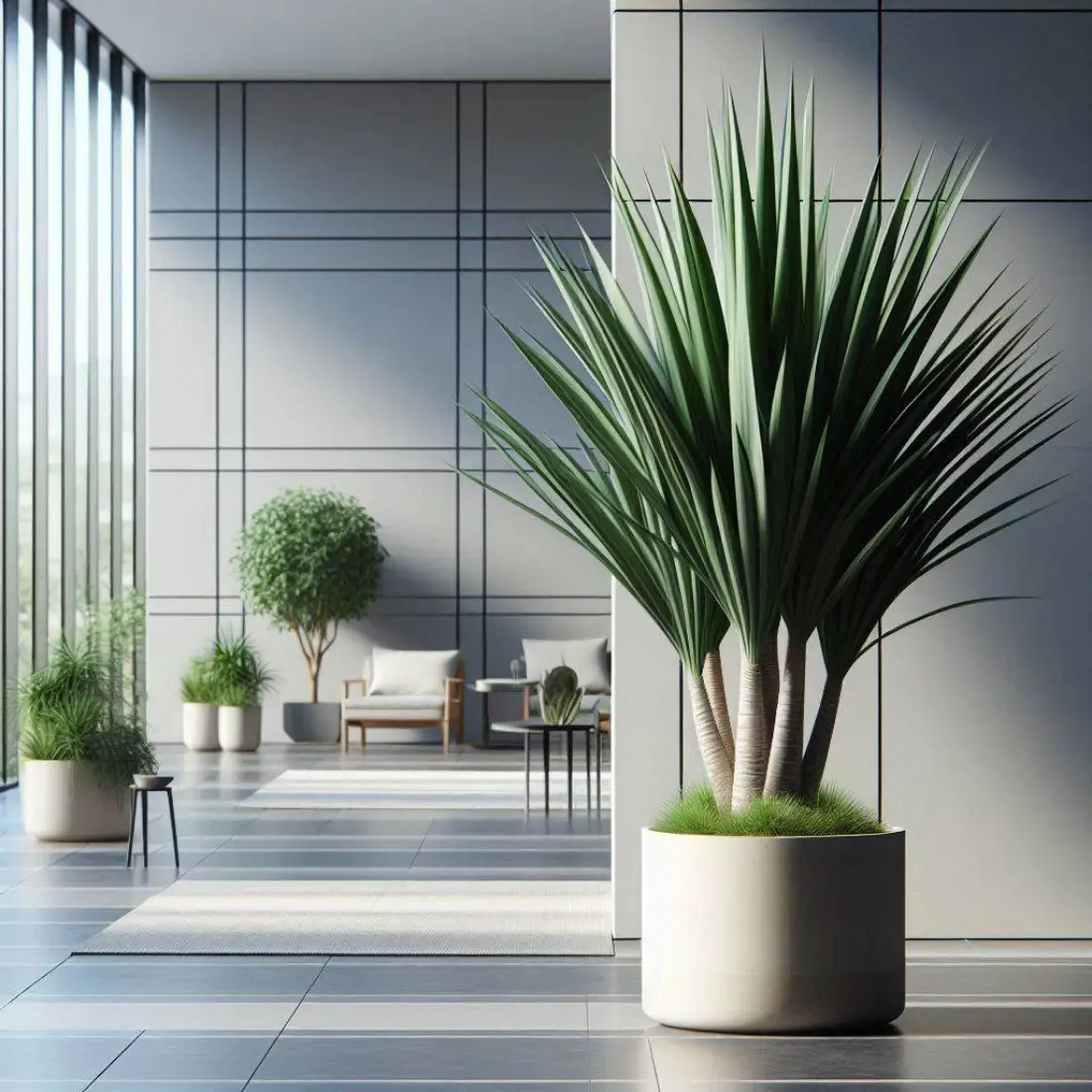The Kentia Palm (Howea Forsteriana) is a popular and elegant house plant known for its graceful, arching fronds and robust nature. Native to Lord Howe Island off the east coast of Australia, this palm has adapted to thrive in indoor environments, making it an ideal choice for plant enthusiasts and beginners alike.
The popularity of the Kentia Palm as a houseplant can be attributed to its low maintenance requirements and its ability to adapt to a variety of indoor conditions.
Unlike many other palms, the Kentia can tolerate lower light levels and is less demanding in terms of humidity, making it suitable for a wide range of home environments. Additionally, its slow growth rate means it will retain its elegant form without quickly outgrowing its space.
Beyond its visual appeal, the Kentia Palm also offers practical benefits. It is known for its air-purifying qualities, helping to remove toxins from the air and improve indoor air quality. This makes it not only a beautiful addition to your home but also a beneficial one for your overall well-being.
[zynith-toc]
Choosing the Right Environment
Creating the optimal environment for your Kentia Palm (Howea forsteriana) is crucial for its health and growth.
Light Requirements
- Bright, Indirect Light: Kentia Palms thrive in bright, indirect light. Place the palm near a window where it can receive filtered sunlight. Direct sunlight can scorch the leaves, so it’s important to avoid placing it in direct sun exposure.
- Tolerance to Lower Light: One of the reasons Kentia Palms are popular indoor plants is their ability to tolerate lower light conditions. While they do best in bright, indirect light, they can also adapt to lower light areas, making them versatile for different rooms in your home.
Temperature
- Ideal Temperature Range: The Kentia Palm prefers a consistent temperature range between 65-75°F (18-24°C). This temperature range mimics its natural habitat and supports healthy growth.
- Avoid Temperature Extremes: It’s important to protect the palm from temperature extremes. Avoid placing it near drafts, such as those from air conditioners or heaters, as sudden temperature changes can stress the plant.
Humidity
Moderate Humidity: Kentia Palms prefer moderate humidity levels. While they are relatively tolerant of typical indoor humidity, they benefit from environments that are not too dry. Aim for humidity levels around 40-60%.
Increasing Humidity: If your home tends to be dry, especially during winter months, there are several ways to increase humidity around your Kentia Palm:
- Pebble Trays: Place the pot on a tray filled with pebbles and water. As the water evaporates, it will increase the humidity around the plant.
- Misting: Lightly mist the fronds with water a few times a week to add moisture to the air.
- Humidifiers: Using a humidifier in the room can help maintain consistent humidity levels, benefiting both the plant and your indoor air quality.
By understanding and providing the right light, temperature, and humidity conditions, you can create an environment where your Kentia Palm will flourish. Paying attention to these factors will help ensure that your palm remains healthy and vibrant, adding beauty and a tropical touch to your home.
Planting and Potting
Proper planting and potting are essential for the healthy growth of your Kentia Palm (Howea forsteriana).
Soil Requirements
Well-Draining Potting Mix: Kentia Palms require a well-draining potting mix to prevent waterlogged roots, which can lead to root rot. A mix specifically designed for palms or a general houseplant potting mix with added perlite or sand to improve drainage is ideal.
Ideal Soil Composition: A good soil mix for Kentia Palms typically includes:
- Peat or coir for moisture retention
- Perlite or sand for drainage
- A small amount of compost for nutrients
Choosing the Right Pot
- Size and Type of Pot: Select a pot that is only slightly larger than the root ball of the palm. A pot that is too large can retain excess moisture, increasing the risk of root rot. Terra cotta pots are a good option as they allow for better air circulation and evaporation of excess moisture.
- Importance of Drainage Holes: Ensure that the pot has adequate drainage holes at the bottom. Proper drainage is crucial to prevent water from accumulating at the bottom, which can cause root rot.
Repotting Guidelines
Kentia Palms are slow-growing and generally do not require frequent repotting. Repotting every 2-3 years is sufficient, or when you notice the roots are becoming pot-bound (roots circling the inside of the pot).
Steps for Repotting:
- Preparation: Choose a pot that is 1-2 inches larger in diameter than the current pot. Have fresh potting mix ready.
- Removing the Plant: Gently remove the palm from its current pot. If the roots are tightly bound, carefully loosen them.
- Trimming Roots: If necessary, trim any damaged or excessively long roots with clean, sharp scissors.
- Planting: Place a layer of fresh potting mix at the bottom of the new pot. Position the palm in the center and fill around the sides with more potting mix, ensuring the root ball is covered but the base of the plant is at the same level as before.
- Watering: Water the palm thoroughly after repotting to settle the soil and eliminate air pockets. Allow excess water to drain away completely.
By following these guidelines for soil, pot selection, and repotting, you can create a stable and supportive environment for your Kentia Palm to grow. Proper planting and potting are the foundations of a healthy, thriving palm that will continue to enhance your home for years to come.
Watering and Organic Feeding
Ensuring your Kentia Palm (Howea forsteriana) receives the proper amount of water and nutrients is essential for its health and vitality.
Watering Frequency
Importance of Allowing Soil to Dry Between Waterings: Kentia Palms prefer their soil to dry out slightly between waterings. Overwatering can lead to root rot, while underwatering can cause the fronds to turn brown and dry out.
Watering Schedule:
- During the growing season (spring and summer), water the palm when the top inch of soil feels dry to the touch. This usually means watering every 7-10 days.
- In the dormant season (fall and winter), reduce watering frequency to every 2-3 weeks, allowing the soil to dry out more between waterings.
Water thoroughly until water flows out of the drainage holes. Discard any excess water in the saucer to prevent water from sitting at the base of the pot.
How to Water Organic Indoor Plants: The Ultimate Guide
Signs of Overwatering and Underwatering:
- Overwatering: Yellowing leaves, soggy soil, and a musty smell indicate overwatering.
- Underwatering: Brown, crispy leaf tips, and dry, compacted soil indicate underwatering.
Organic Feeding Schedule
Use a balanced, organic fertilizer to provide essential nutrients. Options include:
- Liquid seaweed or fish emulsion
- Compost tea
- Worm castings
Frequency of Fertilization:
- During the growing season, feed the palm once a month with a diluted organic fertilizer.
- Reduce feeding to once every two months during the dormant season.
Application Methods:
- Liquid Fertilizer: Mix the recommended amount with water and apply during regular watering. Ensure the soil is moist before applying liquid fertilizer to avoid root burn.
- Compost Tea: Brew compost tea and water the plant with it, providing a gentle nutrient boost.
- Worm Castings: Sprinkle a thin layer of worm castings on top of the soil and lightly work it into the surface. Water thoroughly after application.
By adhering to a consistent watering schedule and using organic fertilizers, you can ensure that your Kentia Palm receives the moisture and nutrients it needs to thrive. Proper watering and feeding practices will promote healthy growth, vibrant foliage, and a robust root system, enhancing the overall health and beauty of your palm.
Pruning and Maintenance
Regular pruning and maintenance are crucial for keeping your Kentia Palm (Howea forsteriana) healthy and attractive.
Removing Dead or Yellowing Fronds:
- Identifying Fronds to Remove: Look for fronds that are completely yellow, brown, or dried out. These are no longer contributing to the plant’s health and should be removed.
- Pruning Technique: Use clean, sharp pruning shears or scissors to cut the frond at its base, near the trunk. Be careful not to damage the trunk or other healthy fronds.
Encouraging Healthy Growth:
- Avoid Over-Pruning: Only remove fronds that are completely dead or yellow. Over-pruning can stress the plant and inhibit its growth.
- Timing: Prune during the growing season (spring and summer) when the plant can quickly recover. Avoid heavy pruning during the dormant season (fall and winter).
Cleaning the Leaves
- Wiping with a Damp Cloth: Use a soft, damp cloth to gently wipe the leaves. This removes dust and keeps the leaves looking fresh and able to photosynthesize efficiently.
- Using a Mild Soap Solution: For particularly dirty leaves, mix a few drops of mild soap in water and use this solution to clean the leaves. Rinse with plain water afterward to avoid soap residue.
Importance of Leaf Maintenance:
- Photosynthesis: Clean leaves can photosynthesize more effectively, promoting better growth and overall health.
- Aesthetics: Regular cleaning keeps the palm looking vibrant and attractive.
- Pest Prevention: Cleaning leaves can help prevent pest infestations by removing potential hiding spots and food sources.
Maintaining Ideal Conditions:
- Consistent Environment: Maintain stable light, temperature, and humidity conditions. Sudden changes can stress the plant.
- Proper Watering and Feeding: Follow the recommended watering and feeding guidelines to ensure the palm receives adequate moisture and nutrients.
Periodic Soil Refreshing:
- Top-Dressing: Once a year, remove the top inch of soil and replace it with fresh potting mix. This can help replenish nutrients and improve soil aeration.
- Full Soil Change: During repotting, replace the old soil completely with fresh potting mix to provide a nutrient-rich environment.
Propagation
Propagating a Kentia Palm (Howea forsteriana) can be a rewarding but challenging process, primarily due to its slow growth rate and specific propagation requirements.
Seed Propagation:
- Availability of Seeds: Kentia Palm seeds are the primary method of propagation. They are usually obtained from specialized nurseries or online suppliers.
- Seed Preparation: Fresh seeds have a higher germination rate. If you purchase dried seeds, soak them in warm water for 2-3 days to rehydrate them before planting.
Planting Seeds:
- Use a well-draining seed-starting mix, such as a combination of peat moss and perlite.
- Plant seeds about 1-2 inches deep in individual pots to avoid disturbing the roots later.
- Keep the soil consistently moist but not waterlogged.
Germination Conditions:
- Maintain a warm temperature of around 75-85°F (24-29°C) using a heat mat if necessary.
- Cover the pots with plastic wrap or place them in a greenhouse to maintain humidity.
- Germination can take several months, so be patient and check the moisture levels regularly.
Challenges and Tips for Successful Propagation:
- Patience: Kentia Palm seeds take a long time to germinate and grow. Be prepared for a lengthy process.
- Consistency: Maintain consistent moisture, temperature, and humidity to improve the chances of successful germination.
- Careful Handling: Once seedlings emerge, handle them with care to avoid damaging the delicate roots.
Care for Seedlings
- Light: Provide bright, indirect light to the seedlings. Avoid direct sunlight, which can scorch the young plants.
- Water: Keep the soil evenly moist but not waterlogged. Overwatering can lead to root rot, especially in young plants.
Transplanting Young Plants:
Timing: Wait until the seedlings have developed several sets of fronds and a robust root system before transplanting.
Transplanting Process:
- Choose small pots with well-draining soil similar to the seed-starting mix.
- Carefully remove the seedlings from their original pots, keeping as much of the root system intact as possible.
- Plant them at the same depth as they were in their previous pots.
- Water thoroughly after transplanting and maintain consistent moisture levels.
Ongoing Care:
- Feeding: Once the seedlings are established, begin feeding them with a diluted organic fertilizer during the growing season.
- Pruning: Trim any damaged or yellowing fronds to encourage healthy growth.
- Monitoring: Keep an eye out for pests and diseases, and address any issues promptly to prevent damage to the young plants.
Common Issues and Solutions
While the Kentia Palm (Howea forsteriana) is relatively low-maintenance, it can still encounter several common issues.
Common Pests:
- Spider Mites: Tiny, web-producing insects that suck sap from the leaves, causing stippling and yellowing.
- Mealybugs: White, cottony pests that cluster on stems and leaves, feeding on plant sap.
- Scale Insects: Hard or soft-bodied insects that attach to leaves and stems, appearing as small bumps.
Treatment Options:
Insecticidal Soap: Spray affected areas with insecticidal soap, ensuring thorough coverage. Repeat applications may be necessary.
Neem Oil: Use neem oil as a natural pesticide. Apply it to the leaves and stems, following the product instructions.
Manual Removal: For larger pests like mealybugs and scale, gently remove them with a cotton swab dipped in rubbing alcohol.
Diseases
Root Rot:
Cause: Overwatering and poorly draining soil lead to root rot, characterized by a foul smell and black, mushy roots.
Prevention: Ensure the pot has adequate drainage holes and use a well-draining potting mix. Allow the soil to dry out between waterings.
Treatment: If root rot is detected, remove the affected roots and repot the plant in fresh, dry soil. Reduce watering frequency.
Fungal Issues:
Symptoms: Yellowing or browning leaves, black spots, and wilting can indicate fungal infections.
Prevention: Maintain good air circulation around the plant and avoid overhead watering. Remove dead or decaying plant material promptly.
Treatment: Use a fungicide designed for houseplants, following the product instructions. Isolate the plant to prevent the spread of the fungus.
Nutrient Deficiencies
- Yellowing Leaves: Nitrogen deficiency often causes older leaves to turn yellow.
- Stunted Growth: Lack of essential nutrients can result in slow or stunted growth.
- Leaf Discoloration: Deficiencies in potassium, magnesium, or iron can cause various discoloration patterns, such as yellow or brown leaf edges or interveinal chlorosis (yellowing between leaf veins).
Corrective Measures:
Balanced Fertilization: Use a balanced, organic fertilizer to ensure the plant receives essential nutrients. Follow the recommended feeding schedule.
Soil Testing: Test the soil to determine specific nutrient deficiencies. Amend the soil with appropriate supplements based on the test results.
Regular Feeding: Maintain a regular feeding schedule during the growing season to provide consistent nutrient availability.
FAQs about Kentia Palm (Howea Forsteriana)
How often should I water my Kentia Palm?
During the growing season (spring and summer), water your Kentia Palm when the top inch of soil feels dry, typically every 7-10 days. In the dormant season (fall and winter), reduce watering to every 2-3 weeks, allowing the soil to dry out more between waterings.
What type of soil is best for Kentia Palms?
Kentia Palms thrive in well-draining soil. A mix specifically designed for palms or a general houseplant potting mix with added perlite or sand to improve drainage is ideal.
Can Kentia Palms tolerate low light conditions?
Yes, Kentia Palms can tolerate lower light conditions, making them versatile for various indoor settings. However, they prefer bright, indirect light for optimal growth.
How do I know if my Kentia Palm is overwatered?
Signs of overwatering include yellowing leaves, soggy soil, and a musty smell. Overwatering can lead to root rot, so it’s important to let the soil dry out slightly between waterings.
When and how should I repot my Kentia Palm?
Repot your Kentia Palm every 2-3 years or when it becomes root-bound. Choose a pot that is 1-2 inches larger in diameter than the current one and use fresh, well-draining potting mix. Gently remove the plant, trim any damaged roots, and replant at the same depth.
What are common pests that affect Kentia Palms, and how can I treat them?
Common pests include spider mites, mealybugs, and scale insects. Treat infestations with insecticidal soap, neem oil, or by manually removing the pests with a cotton swab dipped in rubbing alcohol.
How can I increase the humidity around my Kentia Palm?
Increase humidity by placing a pebble tray filled with water beneath the pot, misting the fronds regularly, or using a humidifier in the room.
Why are the tips of my Kentia Palm’s leaves turning brown?
Brown leaf tips can result from underwatering, low humidity, or exposure to drafts or direct sunlight. Ensure consistent watering, maintain adequate humidity, and protect the plant from harsh environmental conditions.
Can I propagate my Kentia Palm from cuttings?
No, Kentia Palms cannot be propagated from cuttings. They are typically propagated from seeds, which can be a slow and challenging process.
How do I fertilize my Kentia Palm organically?
Feed your Kentia Palm with a balanced, organic fertilizer such as liquid seaweed, fish emulsion, compost tea, or worm castings. During the growing season, apply the fertilizer once a month, and reduce feeding to once every two months during the dormant season.









